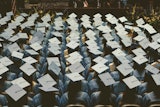The ways in which community colleges and other institutions structure their students’ learning experience through policy, pedagogy and practice can play a significant role in shaping students’ academic mindset, according to a new report released this week from the University of Texas at Austin’s Center for Community College Student Engagement (CCCSE).
 Dr. Evelyn N. Waiwaiole
Dr. Evelyn N. Waiwaiole
CCCSE’s report, “A Mind at Work: Maximizing the Relationship between Mindset and Student Success,” notes that cultivating a more productive academic mindset – the student’s belief that they can change their intelligence, be confident in their ability to learn challenging material and accomplish difficult tasks – can increase students’ levels of engagement, raise their GPAs and positively impact their collegiate success.
“A Mind at Work” signals an opportunity for community colleges to use a mindset lens to reform their approaches to grow students’ productive academic mindset by helping students process setbacks, improving their advising experience and providing professional development to faculty around mindset development, among other strategies.
“Ten years ago, you wouldn’t have had as many colleges making orientation mandatory [or] having first-year students be required to take a student success course. All of those things are creating a sense of belonging,” said Dr. Evelyn N. Waiwaiole, executive director of the Center for Community College Student Engagement. “The colleges are being much more intentional about it.”
CCCSE’s report offers results from the first large set of data on mindset in community colleges. It focuses on four “interconnected” components of academic mindset: growth vs. fixed mindset; self-efficacy, relevance of academic experience; and sense of belonging.
Researchers received responses from 82,821 students from 159 colleges about academic mindset as part of the 2018 Community College Survey of Student Engagement. The center then divided students into seven groups depending on their responses, with Group 1 students having the strongest nonproductive mindset and Group 7 students having the strongest productive mindset.
Few students have “fully productive” or “fully nonproductive” mindsets, the report found. Most students have a partially productive or mixed mindset and fall within Group 4 (nearly four out of 10 students).
This finding is “really positive” because it is easier for college officials to lead mixed mindset or neutral students towards a productive mindset, Waiwaiole said.
“It’s when you’re a nonproductive mindset that it’s harder to work with because you’re pretty determined in what you believe,” she said.
Student respondents that clustered on the nonproductive mindset end of the spectrum tend to do so particularly in the areas of testing and math, according to the report. This finding raises an opportunity for community college leaders to help align students’ math courses with their programs of study and help students reframe their overall thinking in these areas, the report said.
“The first set of work that happens at these institutions is not with the students; it’s about working with the faculty,” Waiwaiole said, highlighting report findings that showed that, although 41 percent of faculty respondents are confident that their students can change their basic intelligence, 24 percent believe that only some or none of their students can change their basic intelligence.
“We’ve got to work with [faculty] to change their own mindset and get them to believe that all students can change their intelligence,” Waiwaiole said. “That’s the first place to begin.”
Institutions such as Seattle Central College and Cleveland State Community College have started faculty workshops on “Productive Persistence” and faculty learning communities, respectively, to share the best strategies to move students towards a growth mindset. Faculty members then have an opportunity to integrate the strategies into their own pedagogies and student support areas.
Exposing students to the concept of the growth mindset has also been integral. At Cleveland State, for instance, a growth mindset module embedded into students’ First Year Seminar resulted in 55 percent of students identifying with a growth mindset, compared to 35 percent before completing the module.
In addition, Dr. Wendy Rockhill, dean for Science, Technology, Engineering, and Mathematics + Business at Seattle Central College, said that when the school joined the Statway Math Pathways Project in 2009 as part of the Carnegie Foundation for the Advancement for Teaching’s (CFAT) efforts around student success and completion in pre-college math and statistics, the goal of the project was to “provide contextualized course content and implement holistic student learning strategies that would be beneficial to students who are likely to have more anxiety and fear around learning math.”
The Productive Persistence approach that came out of this work focuses on the non-cognitive aspects of learning such as changing students’ beliefs about learning, belonging, and relevance of subject matter, Rockhill added.
“It is important for faculty to help students to see themselves as learners,” Rockhill said. “Rather than have a student say ‘I am poor at math,’ or ‘I cannot do this, I do not have the ‘math gene’,’ students see the effort and struggle it takes to learn and that they are capable of learning when using effective strategies.”
As a result of leaders’ efforts, Seattle Central is seeing more students continue and complete their math pathways, more faculty are reinforcing and continuing effective student learning strategies around math and other STEM courses, and significantly, students are helping other students based on their own learning processes.
CCCSE’s report outlined several other findings from the center’s 2018 survey:
-Seventy-six percent of students agreed that they can “always greatly change how intelligent I am”;
-Fifty-five percent of students agreed that, in math, “I can change my intelligence a lot.” In English, 68 percent of students agreed that they could change their intelligence a lot;
-Eighty-two percent of students surveyed agreed that they are confident in their abilities to keep up with the coursework at their college. Fifty-five percent agreed that they can do well on tests even if they are difficult;
-Seventy-nine percent of students agreed that what they learn in their classes is necessary for their future success and that they understand how their academic work is preparing them for their prospective career field;
-Eighty-nine percent of students feel welcomed and respected at their college. Eighty-one percent said they have “good relationships” with others at their college;
-Nontraditional students aged 25 and older had higher academic mindset outcomes than their 18 to 24-year-old peers on several areas related to self-efficacy and relevance of academic experience.
The report provides further case studies, focus group guides and questions for institutions to consider how they can cultivate a growth mindset in students, improve their self-efficacy, enhance students’ understanding of the connections between their courses and academic and professional goals and increase their sense of belonging.
Such efforts will have significant implications for community college students, many of whom are told they are not “college material,” the report said.
“These are the students we owe this to more than anything. Those are the students who already come in and feel that they’re in that fixed category, that they have low self-efficacy,” Waiwaiole said. “We owe it to them to tell them, ‘We can help you.’”
Tiffany Pennamon can be reached at [email protected]. You can follow her on Twitter @tiffanypennamon.
This story first appeared in Diverse: Issues In Higher Education.









